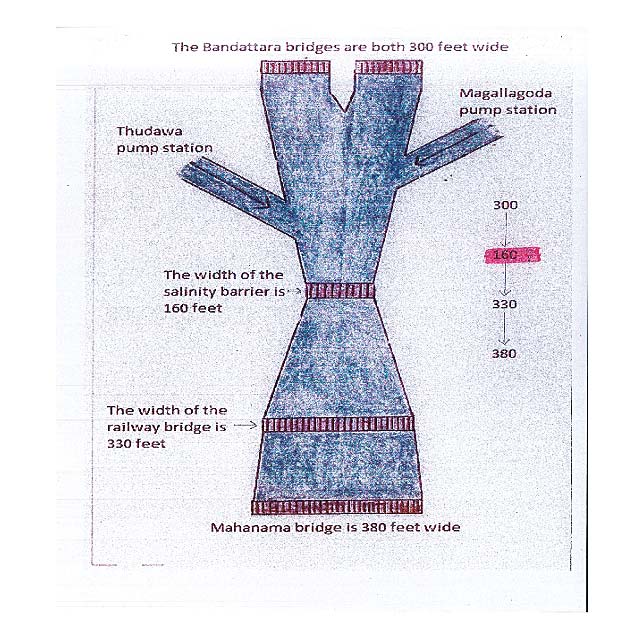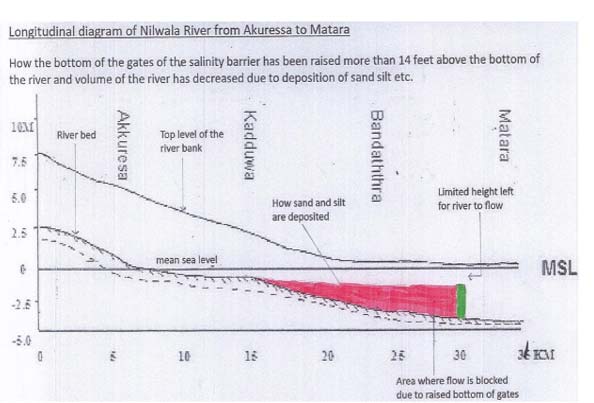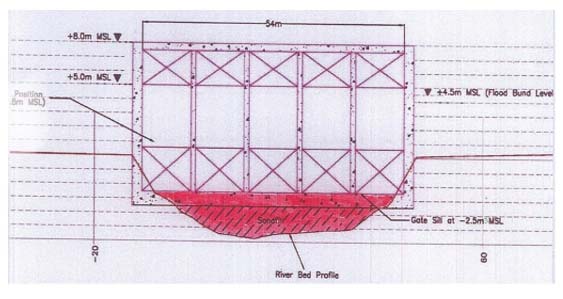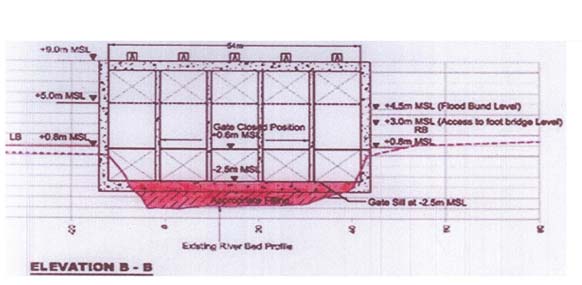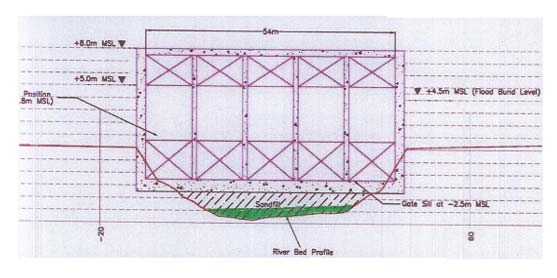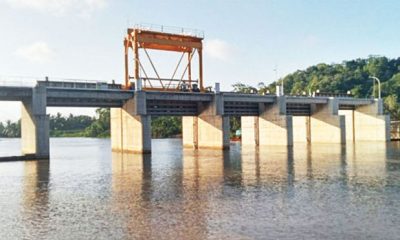Features
Nilwala salinity barrier: Another white elephant
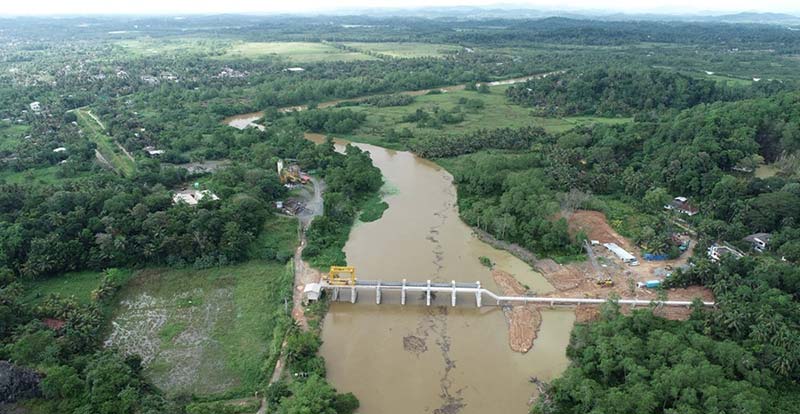
by Matara District Farmers’ Federation
We are writing this in response to the article “The Salinity Barrier and Nilwala Floods: Clearing up Misconceptions by Dr. R. Galappatti, Chairman of Lanka Hydraulic Institute, published in The Island on 01 Jan., 2024.
As farmers, we accept that providing drinking water to the people should be considered a priority and that it is a basic human need. We also accept that after obtaining water for drinking, if there is any excess, it should be used for agricultural purposes. Accordingly, it has been mentioned in the environmental assessment report that the flow of the Nilwala river through the Matara District is sufficient to supply drinking water even during the dry season, and that there will be a surplus even in the year 2045.
The report says that in 2045, the amount of water obtained from the river by the “National Water Supply and Drainage Board” will be 114,000 cubic meters a day. If the withdrawal amount is calculated as a percentage of the water flow in the river even during the dry season with minimum flow, it is almost 55 %. The environmental assessment report has said the removal of that amount will not cause any disturbance to the ecological flow of the river.
The obstacle to continuous water supply during the dry season is the space that is prepared to drain the water by the high flow of water in the river during the rainy season; during the dry season the flow is reduced. Then salt water enters the river during high tide conditions. Therefore, the salinity barrier has been constructed to prevent saltwater from entering the river.
Simply to avoid this situation, the construction of the salinity barrier should have been planned in such a way that the entire cross section of the river could be fully opened during the rainy season and closed thereafter.
But the cross section of the river at the point where the salinity barrier stands has been greatly reduced. Questions about this have been posed to the engineers of the “Irrigation Department”, “National Water Supply and Drainage Board” and “Lanka Hydraulic Institute” at several meetings attended by their officials. But they have gone unanswered. Therefore, we compared the cross-sectional areas of the constructions above and below the salinity barrier with the area of water flow through the cross-sectional area of the salinity barrier. The salinity barrier has reduced the width of the river to more than 75% of its original size in comparison to other constructions. (See diagram 1 – the width is reduced and diagram 2 – cross-sectional area is reduced.)
The worst damage is reduction in depth. The bottom of the gates of the salinity barrier is raised more than 14 feet above the original bottom of the river before construction. Because of this, silt and sand have been deposited more than 15 km upstream from the location of the salinity barrier and the volume of the river has decreased. See diagram 3.
As a result, the river overflows during heavy rains, submerging many areas including paddy fields, marshy lands and roads.
According to the cross-sectional diagram of the salinity barrier included in the environmental study report, that has reduced the depth of the river by more than 14 feet. This mistake cannot be easily rectified. See diagram 4
This depth reduction is a huge mistake and the difference between the depth reduction, i. e. the previous bottom of the river and the concrete placed at the bottom of the gates has been reduced /changed in the cross-sectional photograph of the salinity barrier published with the aforesaid article in The Island. (See in figure 5)
We would like to remind the President of Lanka Hydraulic Institute Dr. R. Galappatti that such incorrect data mislead the public. (See Diagram 5: The diagram (in the environmental assessment report), which has been modified.
Some of the factors neglected in the construction of this salinity barrier are as follows:
01. This construction has been planned ignoring the Nilwala Flood Protection Project, which is the biggest development project implemented in the district along the River.
02. The dimensions (space/volume of water flow) of other structures built across the river in the final reaches of the river (up to 7 km from the mouth of the estuary) have been ignored.
03. Topography of the area has been ignored.
04. The behaviour of rainfall in the catchment area of the river has also been ignored.
05. None of the recommendations mentioned in the technical study report obtained during the environmental study has been taken into consideration. This is a very serious situation.
The Central Environmental Authority (CEA) is also responsible as it did not follow up properly until the completion of the project’s design and construction. Farmers have informed the CEA on several occasions for the past two years or so. On observing the behaviour of the National Water Supply and Drainage Board’, we could see that on several occasions, it acted without even considering the instructions given by the CEA.
06. The Memorandum of Understanding signed between the “Irrigation Department” and the “National Water Supply and Drainage Board” has been violated on several occasions due to the incorrect design prepared by the Lanka Hydraulic Institute.
07. The “National Water Supply and Drainage Board” did not implement the decisions made at the meetings during the construction of the salinity barrier and the recommendations made by the CEA and the “Irrigation Department” on several occasions so all opportunities to rectify this have been missed.
The irrigation control area encompassing “Kiralakele”, “Kadavedduwa” and “Kadduwa”, declared as protected has become unprotected due to the neglect of the Nilwala flood protection project. Paddy lands, roads, houses and lowlands in the area up to “Akuressa” are now submerged even during light showers.
It has been recommended in respect of the unfinished Nilwala flood protection project that action be taken to remove the obstructions including stones on the bottom of the river in the area above the mouth of the estuary, create a bypass canal through the Eliya Kanda area and take necessary measures to ensure a quick flow. The salinity barrier has been a major obstruction to the flow of the river.
The neglect of the Nilwala Flood protecting Project has placed the Matara town at great risk. Due to the salinity barrier blocking the flow of the river, if 400 mm of rain falls within 48 or 72 hours in the upper catchment areas, the flood control dams will be in danger of breaching, and the entire Matara town will be submerged in such an eventuality.
The lower valley of the river from Akuressa to Matara is a plain. The length of the river from Matara to Akuressa is only 32 km. The slope of this plain area is two to three metres. Therefore, during the rainy season, this lower valley is affected by floods because the rainwater from the upper shed area flows rapidly to Akuressa, but beyond Akuressa, it flows slowly to the sea.
A proper study has not been made of the rainfall in the river catchments. When we look at the past rainfall data for the catchment area, it is clear that rainfall increases annually. We believe that if this information had been considered, the salinity barrier would not have been built blocking a part of the cross section of the river.
In addition to the disastrous situation caused by non-drainage during the rainy season, when the gates are closed to prevent seawater from entering to river during the dry season, the water level above the salt barrier is more than 400 to 500 millimeters higher than the downstream, so the drainage of water from the Gravity outlet gates of “Kiralakele” and “Kadawedduwa” farming area stops and both protected irrigation-controlled areas become inactive.
This situation has come about due to the non-implementation of the recommendations mentioned in the technical study report made by the CEA through the “Central Engineering Consultancy Bureau” as stated in the Environmental Assessment Report. A construction plan was prepared without considering the MOU signed by the “Department of Irrigation” and the “National Water Supply and Drainage Board”.
Thus, this project has become a complete failure.
What was published in The Island was from the original cross-sectional diagram attached in the environmental assessment report. There has been an attempt to minimise the extent of the reduction of the river depth. See diagram 6
We would like to tell the Lanka Hydraulic Institute that the ground reality cannot be changed by tampering with original plans and documentation and then publishing them in the newspapers.
We know the importance of providing drinking water. If the salinity barrier had been built in a proper manner, that would have helped manage the drinking water problem without adversely impacting the rice growers and the people living in low-lying areas; that’s why we agreed to this project proposal. But due to mistakes by the Lanka Hydraulic Institute, this project has become a failure.
We request the Lanka Hydraulic Institute to realise the destruction caused by the mistakes in the design of the salinity barrier and have a dialogue with us to rectify the errors.
Features
The heart-friendly health minister

by Dr Gotabhya Ranasinghe
Senior Consultant Cardiologist
National Hospital Sri Lanka
When we sought a meeting with Hon Dr. Ramesh Pathirana, Minister of Health, he graciously cleared his busy schedule to accommodate us. Renowned for his attentive listening and deep understanding, Minister Pathirana is dedicated to advancing the health sector. His openness and transparency exemplify the qualities of an exemplary politician and minister.
Dr. Palitha Mahipala, the current Health Secretary, demonstrates both commendable enthusiasm and unwavering support. This combination of attributes makes him a highly compatible colleague for the esteemed Minister of Health.
Our discussion centered on a project that has been in the works for the past 30 years, one that no other minister had managed to advance.
Minister Pathirana, however, recognized the project’s significance and its potential to revolutionize care for heart patients.
The project involves the construction of a state-of-the-art facility at the premises of the National Hospital Colombo. The project’s location within the premises of the National Hospital underscores its importance and relevance to the healthcare infrastructure of the nation.
This facility will include a cardiology building and a tertiary care center, equipped with the latest technology to handle and treat all types of heart-related conditions and surgeries.
Securing funding was a major milestone for this initiative. Minister Pathirana successfully obtained approval for a $40 billion loan from the Asian Development Bank. With the funding in place, the foundation stone is scheduled to be laid in September this year, and construction will begin in January 2025.
This project guarantees a consistent and uninterrupted supply of stents and related medications for heart patients. As a result, patients will have timely access to essential medical supplies during their treatment and recovery. By securing these critical resources, the project aims to enhance patient outcomes, minimize treatment delays, and maintain the highest standards of cardiac care.
Upon its fruition, this monumental building will serve as a beacon of hope and healing, symbolizing the unwavering dedication to improving patient outcomes and fostering a healthier society.We anticipate a future marked by significant progress and positive outcomes in Sri Lanka’s cardiovascular treatment landscape within the foreseeable timeframe.
Features
A LOVING TRIBUTE TO JESUIT FR. ALOYSIUS PIERIS ON HIS 90th BIRTHDAY

by Fr. Emmanuel Fernando, OMI
Jesuit Fr. Aloysius Pieris (affectionately called Fr. Aloy) celebrated his 90th birthday on April 9, 2024 and I, as the editor of our Oblate Journal, THE MISSIONARY OBLATE had gone to press by that time. Immediately I decided to publish an article, appreciating the untiring selfless services he continues to offer for inter-Faith dialogue, the renewal of the Catholic Church, his concern for the poor and the suffering Sri Lankan masses and to me, the present writer.
It was in 1988, when I was appointed Director of the Oblate Scholastics at Ampitiya by the then Oblate Provincial Fr. Anselm Silva, that I came to know Fr. Aloy more closely. Knowing well his expertise in matters spiritual, theological, Indological and pastoral, and with the collaborative spirit of my companion-formators, our Oblate Scholastics were sent to Tulana, the Research and Encounter Centre, Kelaniya, of which he is the Founder-Director, for ‘exposure-programmes’ on matters spiritual, biblical, theological and pastoral. Some of these dimensions according to my view and that of my companion-formators, were not available at the National Seminary, Ampitiya.
Ever since that time, our Oblate formators/ accompaniers at the Oblate Scholasticate, Ampitiya , have continued to send our Oblate Scholastics to Tulana Centre for deepening their insights and convictions regarding matters needed to serve the people in today’s context. Fr. Aloy also had tried very enthusiastically with the Oblate team headed by Frs. Oswald Firth and Clement Waidyasekara to begin a Theologate, directed by the Religious Congregations in Sri Lanka, for the contextual formation/ accompaniment of their members. It should very well be a desired goal of the Leaders / Provincials of the Religious Congregations.
Besides being a formator/accompanier at the Oblate Scholasticate, I was entrusted also with the task of editing and publishing our Oblate journal, ‘The Missionary Oblate’. To maintain the quality of the journal I continue to depend on Fr. Aloy for his thought-provoking and stimulating articles on Biblical Spirituality, Biblical Theology and Ecclesiology. I am very grateful to him for his generous assistance. Of late, his writings on renewal of the Church, initiated by Pope St. John XX111 and continued by Pope Francis through the Synodal path, published in our Oblate journal, enable our readers to focus their attention also on the needed renewal in the Catholic Church in Sri Lanka. Fr. Aloy appreciated very much the Synodal path adopted by the Jesuit Pope Francis for the renewal of the Church, rooted very much on prayerful discernment. In my Religious and presbyteral life, Fr.Aloy continues to be my spiritual animator / guide and ongoing formator / acccompanier.
Fr. Aloysius Pieris, BA Hons (Lond), LPh (SHC, India), STL (PFT, Naples), PhD (SLU/VC), ThD (Tilburg), D.Ltt (KU), has been one of the eminent Asian theologians well recognized internationally and one who has lectured and held visiting chairs in many universities both in the West and in the East. Many members of Religious Congregations from Asian countries have benefited from his lectures and guidance in the East Asian Pastoral Institute (EAPI) in Manila, Philippines. He had been a Theologian consulted by the Federation of Asian Bishops’ Conferences for many years. During his professorship at the Gregorian University in Rome, he was called to be a member of a special group of advisers on other religions consulted by Pope Paul VI.
Fr. Aloy is the author of more than 30 books and well over 500 Research Papers. Some of his books and articles have been translated and published in several countries. Among those books, one can find the following: 1) The Genesis of an Asian Theology of Liberation (An Autobiographical Excursus on the Art of Theologising in Asia, 2) An Asian Theology of Liberation, 3) Providential Timeliness of Vatican 11 (a long-overdue halt to a scandalous millennium, 4) Give Vatican 11 a chance, 5) Leadership in the Church, 6) Relishing our faith in working for justice (Themes for study and discussion), 7) A Message meant mainly, not exclusively for Jesuits (Background information necessary for helping Francis renew the Church), 8) Lent in Lanka (Reflections and Resolutions, 9) Love meets wisdom (A Christian Experience of Buddhism, 10) Fire and Water 11) God’s Reign for God’s poor, 12) Our Unhiddden Agenda (How we Jesuits work, pray and form our men). He is also the Editor of two journals, Vagdevi, Journal of Religious Reflection and Dialogue, New Series.
Fr. Aloy has a BA in Pali and Sanskrit from the University of London and a Ph.D in Buddhist Philosophy from the University of Sri Lankan, Vidyodaya Campus. On Nov. 23, 2019, he was awarded the prestigious honorary Doctorate of Literature (D.Litt) by the Chancellor of the University of Kelaniya, the Most Venerable Welamitiyawe Dharmakirthi Sri Kusala Dhamma Thera.
Fr. Aloy continues to be a promoter of Gospel values and virtues. Justice as a constitutive dimension of love and social concern for the downtrodden masses are very much noted in his life and work. He had very much appreciated the commitment of the late Fr. Joseph (Joe) Fernando, the National Director of the Social and Economic Centre (SEDEC) for the poor.
In Sri Lanka, a few religious Congregations – the Good Shepherd Sisters, the Christian Brothers, the Marist Brothers and the Oblates – have invited him to animate their members especially during their Provincial Congresses, Chapters and International Conferences. The mainline Christian Churches also have sought his advice and followed his seminars. I, for one, regret very much, that the Sri Lankan authorities of the Catholic Church –today’s Hierarchy—- have not sought Fr.
Aloy’s expertise for the renewal of the Catholic Church in Sri Lanka and thus have not benefited from the immense store of wisdom and insight that he can offer to our local Church while the Sri Lankan bishops who governed the Catholic church in the immediate aftermath of the Second Vatican Council (Edmund Fernando OMI, Anthony de Saram, Leo Nanayakkara OSB, Frank Marcus Fernando, Paul Perera,) visited him and consulted him on many matters. Among the Tamil Bishops, Bishop Rayappu Joseph was keeping close contact with him and Bishop J. Deogupillai hosted him and his team visiting him after the horrible Black July massacre of Tamils.
Features
A fairy tale, success or debacle

Sri Lanka-Singapore Free Trade Agreement
By Gomi Senadhira
senadhiragomi@gmail.com
“You might tell fairy tales, but the progress of a country cannot be achieved through such narratives. A country cannot be developed by making false promises. The country moved backward because of the electoral promises made by political parties throughout time. We have witnessed that the ultimate result of this is the country becoming bankrupt. Unfortunately, many segments of the population have not come to realize this yet.” – President Ranil Wickremesinghe, 2024 Budget speech
Any Sri Lankan would agree with the above words of President Wickremesinghe on the false promises our politicians and officials make and the fairy tales they narrate which bankrupted this country. So, to understand this, let’s look at one such fairy tale with lots of false promises; Ranil Wickremesinghe’s greatest achievement in the area of international trade and investment promotion during the Yahapalana period, Sri Lanka-Singapore Free Trade Agreement (SLSFTA).
It is appropriate and timely to do it now as Finance Minister Wickremesinghe has just presented to parliament a bill on the National Policy on Economic Transformation which includes the establishment of an Office for International Trade and the Sri Lanka Institute of Economics and International Trade.
Was SLSFTA a “Cleverly negotiated Free Trade Agreement” as stated by the (former) Minister of Development Strategies and International Trade Malik Samarawickrama during the Parliamentary Debate on the SLSFTA in July 2018, or a colossal blunder covered up with lies, false promises, and fairy tales? After SLSFTA was signed there were a number of fairy tales published on this agreement by the Ministry of Development Strategies and International, Institute of Policy Studies, and others.
However, for this article, I would like to limit my comments to the speech by Minister Samarawickrama during the Parliamentary Debate, and the two most important areas in the agreement which were covered up with lies, fairy tales, and false promises, namely: revenue loss for Sri Lanka and Investment from Singapore. On the other important area, “Waste products dumping” I do not want to comment here as I have written extensively on the issue.
1. The revenue loss
During the Parliamentary Debate in July 2018, Minister Samarawickrama stated “…. let me reiterate that this FTA with Singapore has been very cleverly negotiated by us…. The liberalisation programme under this FTA has been carefully designed to have the least impact on domestic industry and revenue collection. We have included all revenue sensitive items in the negative list of items which will not be subject to removal of tariff. Therefore, 97.8% revenue from Customs duty is protected. Our tariff liberalisation will take place over a period of 12-15 years! In fact, the revenue earned through tariffs on goods imported from Singapore last year was Rs. 35 billion.
The revenue loss for over the next 15 years due to the FTA is only Rs. 733 million– which when annualised, on average, is just Rs. 51 million. That is just 0.14% per year! So anyone who claims the Singapore FTA causes revenue loss to the Government cannot do basic arithmetic! Mr. Speaker, in conclusion, I call on my fellow members of this House – don’t mislead the public with baseless criticism that is not grounded in facts. Don’t look at petty politics and use these issues for your own political survival.”
I was surprised to read the minister’s speech because an article published in January 2018 in “The Straits Times“, based on information released by the Singaporean Negotiators stated, “…. With the FTA, tariff savings for Singapore exports are estimated to hit $10 million annually“.
As the annual tariff savings (that is the revenue loss for Sri Lanka) calculated by the Singaporean Negotiators, Singaporean $ 10 million (Sri Lankan rupees 1,200 million in 2018) was way above the rupees’ 733 million revenue loss for 15 years estimated by the Sri Lankan negotiators, it was clear to any observer that one of the parties to the agreement had not done the basic arithmetic!
Six years later, according to a report published by “The Morning” newspaper, speaking at the Committee on Public Finance (COPF) on 7th May 2024, Mr Samarawickrama’s chief trade negotiator K.J. Weerasinghehad had admitted “…. that forecasted revenue loss for the Government of Sri Lanka through the Singapore FTA is Rs. 450 million in 2023 and Rs. 1.3 billion in 2024.”
If these numbers are correct, as tariff liberalisation under the SLSFTA has just started, we will pass Rs 2 billion very soon. Then, the question is how Sri Lanka’s trade negotiators made such a colossal blunder. Didn’t they do their basic arithmetic? If they didn’t know how to do basic arithmetic they should have at least done their basic readings. For example, the headline of the article published in The Straits Times in January 2018 was “Singapore, Sri Lanka sign FTA, annual savings of $10m expected”.
Anyway, as Sri Lanka’s chief negotiator reiterated at the COPF meeting that “…. since 99% of the tariffs in Singapore have zero rates of duty, Sri Lanka has agreed on 80% tariff liberalisation over a period of 15 years while expecting Singapore investments to address the imbalance in trade,” let’s turn towards investment.
Investment from Singapore
In July 2018, speaking during the Parliamentary Debate on the FTA this is what Minister Malik Samarawickrama stated on investment from Singapore, “Already, thanks to this FTA, in just the past two-and-a-half months since the agreement came into effect we have received a proposal from Singapore for investment amounting to $ 14.8 billion in an oil refinery for export of petroleum products. In addition, we have proposals for a steel manufacturing plant for exports ($ 1 billion investment), flour milling plant ($ 50 million), sugar refinery ($ 200 million). This adds up to more than $ 16.05 billion in the pipeline on these projects alone.
And all of these projects will create thousands of more jobs for our people. In principle approval has already been granted by the BOI and the investors are awaiting the release of land the environmental approvals to commence the project.
I request the Opposition and those with vested interests to change their narrow-minded thinking and join us to develop our country. We must always look at what is best for the whole community, not just the few who may oppose. We owe it to our people to courageously take decisions that will change their lives for the better.”
According to the media report I quoted earlier, speaking at the Committee on Public Finance (COPF) Chief Negotiator Weerasinghe has admitted that Sri Lanka was not happy with overall Singapore investments that have come in the past few years in return for the trade liberalisation under the Singapore-Sri Lanka Free Trade Agreement. He has added that between 2021 and 2023 the total investment from Singapore had been around $162 million!
What happened to those projects worth $16 billion negotiated, thanks to the SLSFTA, in just the two-and-a-half months after the agreement came into effect and approved by the BOI? I do not know about the steel manufacturing plant for exports ($ 1 billion investment), flour milling plant ($ 50 million) and sugar refinery ($ 200 million).
However, story of the multibillion-dollar investment in the Petroleum Refinery unfolded in a manner that would qualify it as the best fairy tale with false promises presented by our politicians and the officials, prior to 2019 elections.
Though many Sri Lankans got to know, through the media which repeatedly highlighted a plethora of issues surrounding the project and the questionable credentials of the Singaporean investor, the construction work on the Mirrijiwela Oil Refinery along with the cement factory began on the24th of March 2019 with a bang and Minister Ranil Wickremesinghe and his ministers along with the foreign and local dignitaries laid the foundation stones.
That was few months before the 2019 Presidential elections. Inaugurating the construction work Prime Minister Ranil Wickremesinghe said the projects will create thousands of job opportunities in the area and surrounding districts.
The oil refinery, which was to be built over 200 acres of land, with the capacity to refine 200,000 barrels of crude oil per day, was to generate US$7 billion of exports and create 1,500 direct and 3,000 indirect jobs. The construction of the refinery was to be completed in 44 months. Four years later, in August 2023 the Cabinet of Ministers approved the proposal presented by President Ranil Wickremesinghe to cancel the agreement with the investors of the refinery as the project has not been implemented! Can they explain to the country how much money was wasted to produce that fairy tale?
It is obvious that the President, ministers, and officials had made huge blunders and had deliberately misled the public and the parliament on the revenue loss and potential investment from SLSFTA with fairy tales and false promises.
As the president himself said, a country cannot be developed by making false promises or with fairy tales and these false promises and fairy tales had bankrupted the country. “Unfortunately, many segments of the population have not come to realize this yet”.
(The writer, a specialist and an activist on trade and development issues . )

